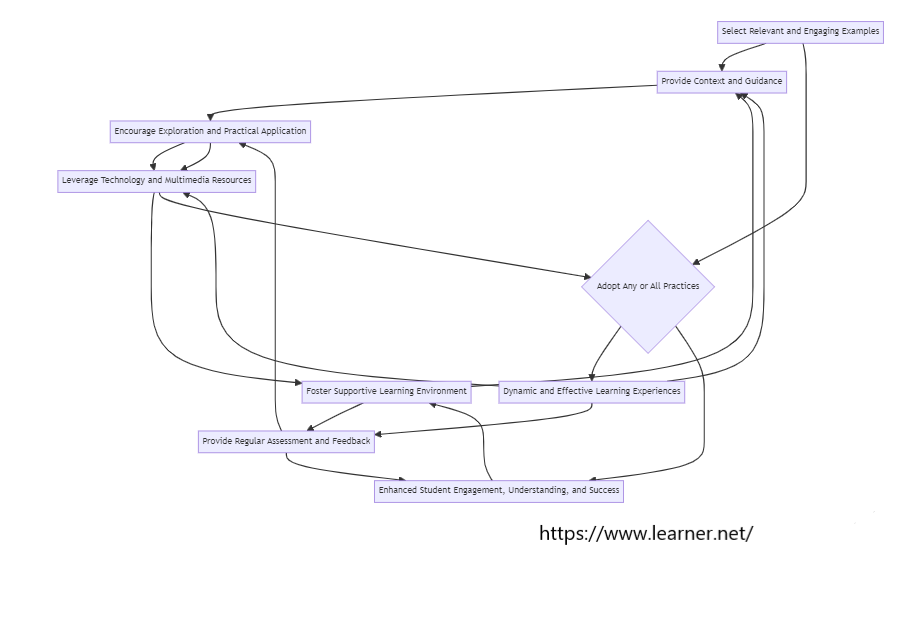Virtual tutoring, a burgeoning facet of modern education, has seen exponential growth with the proliferation of online platforms and digital technologies. This surge in popularity can be attributed to its flexibility, accessibility, and ability to cater to diverse learning needs and schedules. However, while virtual tutoring offers numerous advantages, it also presents unique challenges, particularly in fostering meaningful learning experiences that resonate with students on a personal level.
In the realm of virtual tutoring, the incorporation of real-world examples is increasingly recognized as a vital educational strategy in enhancing student engagement, comprehension, and retention. Unlike traditional classroom settings where tangible experiences may be readily available, virtual environments often lack the immediacy and authenticity of real-world contexts. Consequently, educators must leverage real-world examples to bridge this gap and create immersive learning experiences that resonate with students.
Real-world examples serve as the cornerstone of personalized and contextualized learning experiences, allowing students to connect theoretical concepts with practical applications. By grounding lessons in real-life scenarios, educators can provide relevance and meaning to abstract ideas, fostering deeper understanding and critical thinking skills. Research conducted by the National Research Council emphasizes the importance of contextualized learning, highlighting its effectiveness in promoting transferable skills and long-term retention.
Furthermore, the principles of localization and globalization also play a crucial role in tailoring virtual tutoring experiences to the unique needs and preferences of individual learners in much the same way and for many of the same reasons, and generating similar results. Localization involves adapting content and curriculum to align with the cultural, linguistic, and contextual nuances of specific regions or communities. By incorporating real-world examples that resonate with students’ personal experiences, educators can create coursework that is culturally relevant and relatable, fostering a sense of connection and belonging].
Conversely, globalization emphasizes the interconnectedness of diverse cultures and perspectives, encouraging students to explore global issues and collaborate with peers from around the world. Through the integration of real-world examples from diverse cultural and geographical contexts, educators can broaden students’ horizons, cultivate empathy and cross-cultural understanding, and prepare them for an increasingly interconnected world.
Incorporating real-world examples into virtual tutoring also fosters active and interested student interaction, promoting a deeper level of engagement and participation. By presenting challenges and scenarios that mirror real-life situations, educators can stimulate curiosity, encourage problem-solving skills, and empower students to take ownership of their learning. Research published in the Journal of Educational Psychology suggests that authentic learning experiences promote intrinsic motivation and self-directed learning, leading to improved academic performance and long-term success.
To effectively integrate real-world examples into virtual tutoring, educators can employ various strategies and instructional techniques. Simulation software and virtual labs provide hands-on learning experiences in controlled environments, allowing students to explore complex concepts and phenomena in a safe and interactive manner. Case studies and practical scenarios offer real-life examples of theoretical principles in action, encouraging students to analyze, evaluate, and apply their knowledge in context.
Additionally, industry partnerships and guest speakers bring real-world expertise and insights into virtual tutoring sessions, exposing students to professional practices and career pathways. By connecting classroom learning with real-world applications, educators can inspire students to pursue their passions and aspirations, fostering a sense of purpose and direction in their educational pursuits.
The incorporation of real-world examples into virtual tutoring is essential for creating engaging, relevant, and relatable learning experiences. By leveraging the principles of localization and globalization, educators can tailor coursework to resonate with students personally while fostering cross-cultural understanding and global awareness. Through active and interested interaction, students are empowered to apply their knowledge in meaningful ways, paving the way for lifelong learning and success.
The Significance of Real-World Examples in Online Education
Real-world examples play a pivotal role in both online education and traditional educational institutions, serving as indispensable tools in enhancing understanding, retention, and critical thinking skills among students. In the realm of online education, where the physical classroom is replaced by virtual interfaces, the integration of real-world examples becomes even more crucial in fostering meaningful learning experiences. Similarly, in traditional educational settings, educators recognize the value of incorporating real-world contexts to bridge the gap between theoretical knowledge and practical application.
One of the key benefits of utilizing real-world examples in education is the enhancement of understanding and retention among students. Research conducted by the National Research Council emphasizes the importance of contextualized learning, suggesting that presenting information within meaningful and relevant contexts enhances comprehension and promotes long-term retention. By grounding abstract concepts in real-life scenarios, educators can provide students with tangible reference points that facilitate deeper understanding and facilitate memory consolidation.
Moreover, real-world examples serve as effective tools for bridging theory with practice, enabling online students to apply theoretical knowledge in practical contexts even within the confines of the digital realm. Whether in online modules or traditional classrooms, the incorporation of real-world scenarios allows students to see the direct relevance of their learning to real-life situations. This application-oriented approach not only reinforces learning but also cultivates problem-solving skills and analytical thinking.
Furthermore, the use of real-world examples encourages critical thinking skills by prompting students to analyze, evaluate, and synthesize information in context. By presenting students with complex real-world problems, educators challenge them to think critically, consider multiple perspectives, and develop innovative solutions.
The benefits of integrating real-world examples extend far beyond academic success, providing students with skills and competencies that are essential for success in their personal and professional lives. By engaging in real-world problem-solving activities, students develop resilience, adaptability, and creativity, all being qualities that are highly valued in today’s rapidly changing world. Additionally, the ability to apply theoretical knowledge to practical situations fosters a sense of confidence and self-efficacy, empowering students to navigate real-world challenges with competence and resilience.
The significance of real-world examples in education cannot be overstated. Whether in online learning environments or traditional classrooms, the integration of real-world contexts enhances understanding, retention, and critical thinking skills among students. By bridging theory with practice and encouraging active engagement, real-world examples prepare students for success not only in their academic pursuits but also in their personal and professional lives.
Challenges in Virtual Tutoring
Virtual tutoring presents a myriad of challenges that educators must navigate to ensure effective learning experiences for students. One of the primary challenges is the limited engagement and interaction inherent in virtual settings. Unlike traditional classrooms where face-to-face interactions foster dynamic exchanges, virtual environments may lack the immediacy and spontaneity of in-person communication. This can result in decreased student engagement and participation, hindering the effectiveness of virtual tutoring sessions.
Another challenge in virtual tutoring is the difficulty in applying abstract concepts without hands-on experience. In subjects such as science, engineering, and technology, where practical application is integral to understanding complex theories, the absence of hands-on activities can impede learning. Virtual labs and simulation software offer partial solutions, but they may not fully replicate the tactile and sensory experiences of traditional laboratory settings.
Furthermore, some online courses may suffer from outdated modes of teaching, particularly when educators have not fully adapted to the digital classroom. Instructors accustomed to traditional teaching methods may struggle to leverage technology effectively, leading to uninspired or ineffective virtual tutoring sessions. This can create a disconnect between educators and students, resulting in disengagement and frustration among learners.
Addressing these challenges requires a multifaceted approach that prioritizes innovation, adaptability, and student-centered learning. Educators must leverage technology to enhance engagement and interaction in virtual tutoring sessions. This can be achieved through the use of interactive multimedia tools, virtual collaboration platforms, and gamified learning experiences.
Additionally, educators should strive to make abstract concepts more tangible and accessible to students by incorporating real-world examples and practical applications into their virtual tutoring sessions. By contextualizing learning within familiar and relevant contexts, educators can facilitate deeper understanding and retention among students.
Furthermore, professional development opportunities and ongoing training can help educators stay abreast of emerging technologies and best practices in online teaching. By equipping educators with the necessary skills and resources, institutions can empower them to embrace the digital classroom with confidence and proficiency.
While virtual tutoring offers numerous benefits, it also poses unique challenges that must be addressed to optimize student learning outcomes. From limited engagement and interaction to the difficulty in applying abstract concepts, educators must navigate a variety of obstacles to ensure effective virtual tutoring experiences. By embracing innovation, leveraging technology, and prioritizing student-centered learning, educators can overcome these challenges and create dynamic and engaging virtual learning environments.
Successful Strategies for Incorporating Real-World Examples in Online Education
Successful strategies for incorporating real-world examples in online education encompass a range of innovative approaches aimed at enhancing student engagement, comprehension, and practical application of knowledge.
Among the most common of these strategies is the utilization of simulation software and virtual labs, which provide students with immersive and interactive learning experiences in simulated environments. These tools allow learners to apply theoretical concepts in practical scenarios, fostering critical thinking and problem-solving skills.
Furthermore, the integration of AI solutions also holds promise for enriching online education by personalizing learning experiences and providing real-time feedback to students. AI-powered adaptive learning platforms analyze student data to tailor instructional content and interventions based on individual learning needs and preferences. This targeted approach not only enhances student engagement but also facilitates deeper understanding and mastery of complex concepts.
Case studies and practical scenarios serve as effective vehicles for incorporating real-world examples into online educational courses. By presenting students with real-life challenges and dilemmas, educators encourage active learning and critical thinking. For example, a case study in business education might involve analyzing market trends and developing strategic solutions for a fictional company, while a practical scenario in healthcare education could simulate patient care scenarios to assess clinical decision-making skills.
The feasibility of establishing industry partnerships and guest speakers for online tutors depends on factors such as accessibility, relevance, and alignment with course objectives. Industry partnerships allow educators to bring real-world expertise and insights into virtual classrooms, exposing students to professional practices and career pathways. Similarly, guest speakers can provide firsthand perspectives and experiences that enrich online tutoring sessions. For instance, a guest lecture from a leading expert in the field can offer valuable insights and inspiration to students pursuing careers in STEM fields.
Moreover, industry partnerships and guest speakers can facilitate networking opportunities and career connections for students, enhancing their employability and professional development. By engaging with industry professionals, students gain exposure to current trends, best practices, and emerging technologies, preparing them for success in the workforce.
Successful strategies for incorporating real-world examples in online education involve a combination of innovative tools, instructional methods, and collaborative partnerships. Simulation software and virtual labs offer immersive learning experiences, while AI solutions personalize instruction and feedback. Case studies and practical scenarios encourage active learning and critical thinking, while industry partnerships and guest speakers provide real-world perspectives and insights. By leveraging these strategies, educators can create dynamic and engaging online learning environments that prepare students for success in the digital age.
The Importance of Continual Evaluation and Assessment
The continual evaluation and assessment of the lessons are integral components of effective online tutoring, ensuring that instructional strategies are aligned with learning objectives and student needs. One aspect of evaluation and assessment is measuring the effectiveness of real-world examples used in online tutoring. By collecting data on student engagement, comprehension, and performance, tutors can gauge the impact of real-world examples on learning outcomes.
Furthermore, collecting feedback from students is essential for understanding their experiences, preferences, and areas of improvement. Tutors can solicit feedback through surveys, assessments, and discussion forums, allowing students to provide insights into the relevance, clarity, and effectiveness of real-world examples in their learning.
Continually adjusting strategies based on performance data is essential for optimizing the inclusion of real-world examples within coursework. Tutors should analyze performance data to identify patterns, trends, and areas for improvement. This data-driven approach allows tutors to refine instructional methods, select more relevant and engaging examples, and tailor instruction to meet the diverse needs of students.
Moreover, evaluating the efficacy of real-world examples within coursework involves assessing their impact on student learning outcomes, such as comprehension, retention, and application of knowledge. Tutors can use pre-and post-assessments, quizzes, and project evaluations to measure the extent to which students have mastered key concepts and skills introduced through real-world examples.
Additionally, ongoing assessment of student progress and performance allows tutors to identify struggling students and provide targeted support and intervention. By monitoring students’ understanding and engagement, tutors can identify areas where additional assistance or resources may be needed and adjust instruction accordingly[^5].
Continued evaluation and assessment are essential for ensuring the effectiveness of real-world examples in online tutoring. By measuring their impact on student learning outcomes, collecting feedback from students, and continually adjusting strategies based on performance data, tutors can create dynamic and engaging learning experiences that foster deep understanding, critical thinking, and practical application of knowledge.
Best Practices and Tips for Virtual Tutors
These tips for virtual tutors will ideally assist in their ability for creating dynamic and effective learning experiences that engage students and promote meaningful learning outcomes.
One crucial aspect of virtual tutoring is the selection of relevant and engaging examples that resonate with students’ interests, backgrounds, and learning objectives on an individual level. By choosing examples that are relatable and applicable to individual students’ lives, tutors can capture their attention and facilitate a deeper understanding of the material and a more personal and engaged approach by the students towards their studies.
Providing context and guidance is another important aspect of effective virtual tutoring. Tutors should contextualize concepts within real-world scenarios and provide clear explanations of key concepts and principles. Additionally, offering guidance on how to approach problems and tasks can help students navigate complex topics and develop problem-solving skills.
Encouraging exploration and practical application is vital for promoting active learning and retention of knowledge. Tutors should create opportunities for students to apply their learning in real-world contexts through interactive activities, simulations, and projects. This hands-on approach not only reinforces learning but also fosters critical thinking and creativity.
Furthermore, incorporating practical application into coursework where applicable enhances the relevance and applicability of the material to students’ lives. For example, in a language course, tutors can assign tasks that require students to engage with authentic texts or participate in real-life conversations. In a science course, students might conduct experiments or simulations to apply theoretical concepts to practical problems.
Additionally, leveraging technology and multimedia resources can enhance the effectiveness of virtual tutoring. Tutors can use multimedia presentations, interactive simulations, and online resources to supplement traditional instruction and provide additional support to students. This variety of instructional methods caters to different learning styles and preferences, ensuring that all students have access to the resources they need to succeed.
Moreover, fostering a supportive and collaborative learning environment is essential for promoting student engagement and success in virtual tutoring. Tutors should encourage active participation, peer interaction, and constructive feedback among students. Creating opportunities for collaboration and discussion allows students to learn from each other and develop communication and teamwork skills.
Regular assessment and feedback are also critical components of effective virtual tutoring. Tutors should provide timely and constructive feedback on students’ progress and performance, identifying areas for improvement and offering guidance on how to address them. Additionally, ongoing assessment allows tutors to monitor students’ understanding and adjust instruction as needed to ensure that all students are making progress.
Adopting any or all of these practices and tips for virtual tutors should help with creating more engaging, effective, and meaningful learning experiences for their students. By selecting relevant and engaging examples, providing context and guidance, encouraging exploration and practical application, leveraging technology and multimedia resources, fostering a supportive learning environment, and providing regular assessment and feedback, tutors can promote student success and enhance learning outcomes in virtual tutoring environments.
Diagram 1: Best Practices and Tips for Virtual Tutors

A Summary of Real-World Examples in Online Education
Real-world examples play a pivotal role in online education, offering students tangible connections to theoretical concepts and fostering deeper understanding and application of knowledge. By grounding abstract concepts in real-life scenarios, educators can enhance student engagement, retention, and critical thinking skills.
In the realm of virtual tutoring, the potential of real-world examples is particularly pronounced, as they provide opportunities for practical application and experiential learning in simulated environments. Whether through simulation software, virtual labs, or interactive multimedia tools, virtual tutors can immerse students in authentic learning experiences that mirror real-world contexts. This hands-on approach not only reinforces learning but also cultivates problem-solving skills and prepares students for real-world challenges.
As virtual tutoring continues to gain prominence in education, there is a pressing need for educators to integrate more real-world examples into their instructional practices. Whether they are online tutors at Learner Net or educators in traditional classrooms, incorporating real-world examples can enhance the effectiveness of instruction and promote meaningful learning outcomes. By selecting relevant and engaging examples, providing context and guidance, and encouraging exploration and practical application, educators can create dynamic and engaging learning experiences that resonate with students.
Therefore, it is essential for educators to embrace the potential of real-world examples and integrate them into their virtual tutoring sessions. By doing so, they can enhance student engagement, foster critical thinking skills, and prepare students for success in their academic and professional endeavors. Whether teaching math, science, humanities, or any other subject, educators have the opportunity to enrich their instruction and create more meaningful learning experiences by incorporating real-world examples.
Real-world examples are invaluable tools for enhancing learning in online education. With their ability to bridge theory with practice and engage students in authentic learning experiences, real-world examples have the potential to transform virtual tutoring sessions and promote deeper understanding and application of knowledge.






5
/5Based on 0 rating(s)
By 02 reviewer(s)
Temporary Email Services
This is my first time pay a quick visit at here and i am really happy to read everthing at one place
Registro
Can you be more specific about the content of your article? After reading it, I still have some doubts. Hope you can help me.